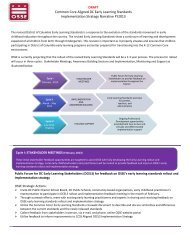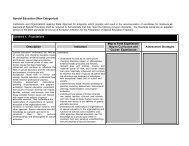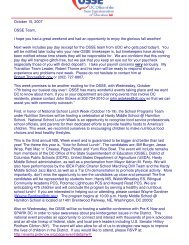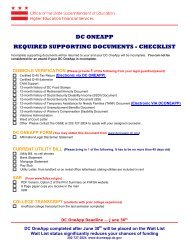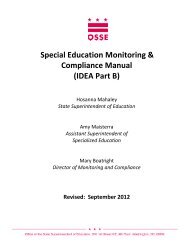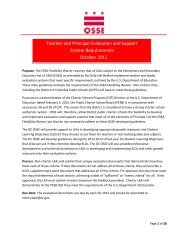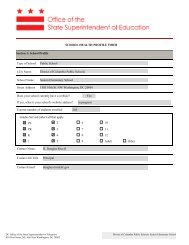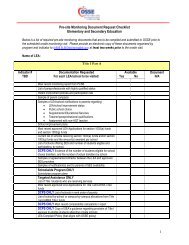DCTAG 10 Years of Performance - osse
DCTAG 10 Years of Performance - osse
DCTAG 10 Years of Performance - osse
Create successful ePaper yourself
Turn your PDF publications into a flip-book with our unique Google optimized e-Paper software.
OFFICE OF THE STATE SUPERINTENDENT OF EDUCATION<br />
DISTRICT OF COLUMBIA<br />
TUITION ASSISTANCE GRANT PROGRAM<br />
1 0 - Y E A R A C C O M P L I S H M E N T S R E P O R T<br />
1 9 9 9 - 2 0 0 9<br />
1 0 - Y E A R A C C O M P L I S H M E N T S R E P O R T 1 9 9 9 - 2 0 0 9 1
2 D . C . T U I T I O N A S S I S T A N C E G R A N T P R O G R A M
Office <strong>of</strong> the State Superintendent <strong>of</strong> Education<br />
D I S T R I C T O F C O L U M B I A<br />
M A Y O R A D R I A N M . F E N T Y<br />
Dear District Residents and Stakeholders,<br />
This annual report marks the ten year anniversary <strong>of</strong> the District <strong>of</strong> Columbia Tuition Assistance Grant<br />
Program (<strong>DCTAG</strong>). <strong>DCTAG</strong> is a unique financial aid program designed to <strong>of</strong>fer DC residents expanded<br />
options and opportunities in their college choices, primarily by paying the difference between in and out-<strong>of</strong>state<br />
tuition costs at public colleges and universities across the country. Over 16,000 students have reaped<br />
the benefits <strong>of</strong> this program in the last ten years, doubling the District’s college-going rate. Moreover, the<br />
<strong>DCTAG</strong> program is a driving force toward the citywide goal <strong>of</strong> doubling the number <strong>of</strong> public school students<br />
who actually receive a college degree.<br />
This significant program has helped make the dream <strong>of</strong> attending college a reality for District residents,<br />
many <strong>of</strong> whom were the first in their families to attend college. Further, the program has expanded to <strong>of</strong>fer<br />
support to schools, students, and families—helping the community make educated choices about college<br />
and succeed in higher education.<br />
While the last decade <strong>of</strong> accomplishments described in this report are impressive, we are equally as excited<br />
about the future <strong>of</strong> the <strong>DCTAG</strong> program. The program and its online application (the DC OneApp) are<br />
poised to provide up-to-date and long-term data on the college-going and success trends <strong>of</strong> DC students.<br />
This information will drive new policies and programs in the District and help to ensure that all residents<br />
receive an excellent education.<br />
We are grateful for the committed support <strong>of</strong> members <strong>of</strong> the United States Congress who have graciously<br />
guided this program. We also appreciate the staff <strong>of</strong> OSSE’s Higher Education Financial Services (HEFS),<br />
particularly its Director, Ms. Rehva Jones, whose dedication to the District’s residents has contributed greatly<br />
to the success <strong>of</strong> this program and keeps it on the cutting edge.<br />
Sincerely,<br />
Kerri L. Briggs, Ph.D.<br />
State Superintendent <strong>of</strong> Education<br />
8<strong>10</strong> First Street, NE, 9th floor, Washington, DC 20002<br />
Phone: 202.727.6436 • Fax: 202.727.2019 • www.<strong>osse</strong>.dc.gov<br />
1 0 - Y E A R A C C O M P L I S H M E N T S R E P O R T 1 9 9 9 - 2 0 0 9 3
Executive Summary<br />
The District <strong>of</strong> Columbia Tuition Assistance Grant (<strong>DCTAG</strong>) has made higher<br />
education more accessible and affordable for thousands <strong>of</strong> District residents.<br />
But as the program marks its <strong>10</strong>th anniversary, it has demonstrated that<br />
access to higher education is about more than money—the data produced<br />
through the program’s implementation holds the key to expanding college<br />
preparedness and persistence District-wide.<br />
A Decade <strong>of</strong> Results<br />
Since its inception in 1999, <strong>DCTAG</strong> has provided more than $235 million to<br />
help 16,000 DC residents afford and attend public institutions in 49 states,<br />
Puerto Rico, and the US Virgin Islands. Through awards <strong>of</strong> up to $<strong>10</strong>,000 a<br />
year, <strong>DCTAG</strong> <strong>of</strong>fers funding to bridge the gap between in-state and out-<strong>of</strong>state<br />
tuition at more than 2,500 public colleges and universities. The program<br />
brings an infusion <strong>of</strong> the District’s students as well as federal dollars to state<br />
university systems across the nation—and returns many <strong>of</strong> its graduates to the<br />
District, where they make lasting contributions to their communities.<br />
Yet even as the ranks <strong>of</strong> <strong>DCTAG</strong>’s beneficiaries increase, the District’s rates<br />
<strong>of</strong> college enrollment and graduation overall remain flat. A 2006 report<br />
estimated that just 9 percent <strong>of</strong> DCPS students who start 9th grade complete<br />
college within five years <strong>of</strong> enrolling—compared to 23 percent <strong>of</strong> students<br />
nationwide. 1 To deliver targeted support and resources to meet this challenge<br />
and boost college enrollment and persistence, the District <strong>of</strong> Columbia<br />
Office <strong>of</strong> the State Superintendent <strong>of</strong> Education (OSSE) is putting the data<br />
generated by <strong>DCTAG</strong> to work.<br />
Meeting the College-Preparedness Challenge<br />
Students apply for <strong>DCTAG</strong> awards using the DC OneApp, an online system<br />
and longitudinal database for tracking data on graduation rates; transfer<br />
patterns; retention success; institutional, student, and staff performance.<br />
Armed with this data, the OSSE is providing school level data on college<br />
choice, enrollment, and persistence trends that enable college access<br />
providers and school principals to craft collaborative solutions that enhance<br />
college preparation, access, and persistence.<br />
Together with universities, national educational organizations, communitybased<br />
nonpr<strong>of</strong>its, and college access providers, the OSSE is leveraging<br />
<strong>DCTAG</strong> to drive new services and supports that will increase not only college<br />
access, but also college graduation rates, for decades to come.<br />
1 Double the Numbers for College Success: A Call to Action for the District <strong>of</strong> Columbia, 2006.<br />
4 D . C . T U I T I O N A S S I S T A N C E G R A N T P R O G R A M
1 0 - Y E A R A C C O M P L I S H M E N T S R E P O R T 1 9 9 9 - 2 0 0 9 5
Timeline<br />
President Bill Clinton signs<br />
the <strong>DCTAG</strong> bill into law<br />
(the District <strong>of</strong> Columbia<br />
College Access Act, PL<br />
<strong>10</strong>6-98), providing $17<br />
million to fund the grants.<br />
President George<br />
H. W. Bush signs the<br />
DC College Access<br />
Improvement Act<br />
<strong>of</strong> 2002, making<br />
private Historically<br />
Black Colleges<br />
and Universities<br />
eligible for $2,500<br />
<strong>DCTAG</strong> grants.<br />
November 1999<br />
April 2002<br />
March 1999<br />
May 2000 June 2001<br />
Rep. Eleanor<br />
Holmes Norton<br />
(DC), Rep. Tom<br />
Davis (VA), and Rep.<br />
Constance Morella<br />
(MD) introduce the<br />
<strong>DCTAG</strong> legislation<br />
to supplement the<br />
tuition <strong>of</strong> qualified<br />
District residents<br />
attending public<br />
colleges and<br />
universities<br />
in Maryland<br />
and Virginia.<br />
District <strong>of</strong> Columbia<br />
Mayor Anthony<br />
Williams expands<br />
the <strong>DCTAG</strong> program<br />
to allow use <strong>of</strong> the<br />
grants at public<br />
postsecondary<br />
education institutions<br />
nationwide. The first<br />
grant <strong>of</strong> $3,759 is<br />
awarded to a student<br />
attending the<br />
Georgia Institute<br />
<strong>of</strong> Technology.<br />
<strong>DCTAG</strong> has<br />
disbursed $9 million<br />
on behalf <strong>of</strong> 1,970<br />
college students<br />
attending colleges<br />
and universities<br />
in 37 states.<br />
6 D . C . T U I T I O N A S S I S T A N C E G R A N T P R O G R A M
Congress increases<br />
the <strong>DCTAG</strong><br />
appropriation from<br />
$17 million to<br />
$25.6 million.<br />
President George<br />
W. Bush approves<br />
an increase in<br />
the <strong>DCTAG</strong><br />
appropriation from<br />
$25.6 million to<br />
$33 million.<br />
Scheduled<br />
reauthorization for<br />
<strong>DCTAG</strong>.<br />
December 2004<br />
December 2006<br />
2012<br />
March 2005<br />
October 2007<br />
The District <strong>of</strong><br />
Columbia launches<br />
DC OneApp—an<br />
online application<br />
system—to<br />
streamline the<br />
process <strong>of</strong> applying<br />
for financial aid for<br />
higher education<br />
and facilitate data<br />
collection on both<br />
student applications<br />
and outcomes.<br />
Congress reauthorizes<br />
the <strong>DCTAG</strong> program<br />
and increases the<br />
appropriation to<br />
$35.1 million.<br />
1 0 - Y E A R A C C O M P L I S H M E N T S R E P O R T 1 9 9 9 - 2 0 0 9 7
1<br />
Creating<br />
Opportunities for<br />
Higher Education<br />
Nationwide<br />
<strong>DCTAG</strong> Eligibility Requirements<br />
An eligible <strong>DCTAG</strong> applicant must be:<br />
• A United States citizen or eligible<br />
non-citizen.<br />
• Domiciled in the District <strong>of</strong> Columbia<br />
for at least 12 consecutive months prior<br />
to the first semester in a college or<br />
university and domiciled in the District<br />
while enrolled in college.<br />
• A high school graduate or GED holder<br />
or accepted in a degree-granting<br />
program as a regular student.<br />
• In good standing with federal<br />
student loans.<br />
• Accepted for enrollment in an associate<br />
or first bachelor degree program on at<br />
least a half-time basis.<br />
• Attending a <strong>DCTAG</strong>-eligible college<br />
or university.<br />
• In satisfactory academic progress, as<br />
defined by the college or university<br />
<strong>of</strong> attendance.<br />
• No more than 24 years old unless<br />
enrolled in <strong>DCTAG</strong> prior to the 2006-<br />
2007 school year.<br />
• Residing in a household with an<br />
adjusted taxable income <strong>of</strong> no more<br />
than $1 million.<br />
For the past decade residents <strong>of</strong> the District <strong>of</strong> Columbia have benefited from<br />
a landmark program that dramatically expands their choices and opportunities<br />
for a college education. Championed by Congresswoman Eleanor Holmes<br />
Norton, the District’s city and regional congressional leadership, community<br />
members, and business leaders, the DC Tuition Assistance Grant (<strong>DCTAG</strong>)<br />
program has made college more accessible and affordable for thousands <strong>of</strong><br />
DC students. As a result, more District residents can afford to attend state<br />
universities across the country—and many return to Washington to make a<br />
lasting contribution to the city’s quality <strong>of</strong> life.<br />
Opening the Doors to College Options<br />
When the District <strong>of</strong> Columbia College Access Act passed in 1999, 64 percent<br />
<strong>of</strong> the District’s college-bound residents enrolled at institutions outside <strong>of</strong><br />
the District, while an average <strong>of</strong> just 15 percent <strong>of</strong> students nationwide<br />
attended college out <strong>of</strong> state. Slightly more than two-thirds <strong>of</strong> these DC<br />
students enrolled at private institutions—twice the rate <strong>of</strong> students from<br />
other states. As a result, they paid twice the national average annual tuition<br />
for dependent students. 2<br />
<strong>DCTAG</strong> significantly reduced these tuition costs by providing awards towards<br />
the difference between in-state and out-<strong>of</strong>-state tuition—up to $<strong>10</strong>,000 per<br />
year and a lifetime maximum <strong>of</strong> $50,000. Thanks to <strong>DCTAG</strong>, District residents<br />
pay in-state tuition rates to attend many <strong>of</strong> the nation’s more than 2,500 public<br />
colleges and universities. <strong>DCTAG</strong> also <strong>of</strong>fers students up to $2,500 per year<br />
to attend private Historically Black Colleges and Universities (HBCUs), private<br />
nonpr<strong>of</strong>it colleges and universities in the Washington metropolitan area, or<br />
public two-year community colleges nationwide.<br />
With an initial federal appropriation <strong>of</strong> $17 million, the <strong>DCTAG</strong> program began<br />
to bridge the gap between in-state and out-<strong>of</strong>-state tuition rates at eligible<br />
colleges and universities. In the 2007 reauthorization, Congress increased<br />
<strong>DCTAG</strong> funding to $35.1 million per year. Since <strong>DCTAG</strong>’s inception, 16,081<br />
students have received grants averaging $6,587 per year, totaling $235,432,140. 3<br />
In the past <strong>10</strong> years the percentage <strong>of</strong> the District’s high school graduates who<br />
are college bound has doubled to 60 percent—nearly <strong>10</strong> percent more than<br />
the national average.<br />
2 Thomas Kane, Evaluating the Impact <strong>of</strong> the D.C. TAG, Working Paper <strong>10</strong>658, National Bureau <strong>of</strong><br />
Economic Research, August 2004.<br />
3 As <strong>of</strong> December 31, 2009.<br />
8 D . C . T U I T I O N A S S I S T A N C E G R A N T P R O G R A M
Assisting Local Students; Achieving Nationwide Benefits<br />
<strong>DCTAG</strong> participants have attended 300 colleges and universities in 49 states,<br />
bringing an infusion <strong>of</strong> the District’s students as well as federal dollars to state<br />
university systems across the nation.<br />
FIGURE 1: Total <strong>DCTAG</strong> Awards by State<br />
WA<br />
MT<br />
ND<br />
MA<br />
OR<br />
ID<br />
WY<br />
SD<br />
MN<br />
WI<br />
MI<br />
NY<br />
VT NH<br />
MA<br />
CT<br />
RI<br />
CA<br />
NV<br />
UT<br />
CO<br />
NE<br />
KS<br />
IA<br />
MO<br />
IL<br />
IN<br />
KY<br />
OH<br />
WV<br />
PA<br />
MD<br />
VA<br />
DE<br />
NJ<br />
AZ<br />
NM<br />
OK<br />
AK<br />
TN<br />
SC<br />
NC<br />
MS AL GA<br />
TX<br />
LA<br />
AR<br />
FL<br />
HI<br />
= $<strong>10</strong>,000-$199,000<br />
= $200,000-$999,000<br />
= $1,000,000-$19,000,000<br />
= $20,000,000-$39,000,000<br />
= $40,000,000-$50,000,000<br />
1 0 - Y E A R A C C O M P L I S H M E N T S R E P O R T 1 9 9 9 - 2 0 0 9 9
1<br />
Creating<br />
Opportunities for<br />
Higher Education<br />
Nationwide<br />
(continued)<br />
<strong>DCTAG</strong> grantees are highly concentrated at colleges and universities in<br />
Delaware, Maryland, North Carolina, Virginia, and the District <strong>of</strong> Columbia.<br />
From the 2006-2007 school year through the 2008-2009 school year, the<br />
institutions with the highest enrollment <strong>of</strong> <strong>DCTAG</strong> grantees are Montgomery<br />
College (Maryland), North Carolina Agricultural and Technical University, and<br />
Trinity Washington University (DC).<br />
TABLE 1: Top <strong>10</strong> Institutions Enrolling <strong>DCTAG</strong> Students, 2006-2007<br />
through 2008-2009<br />
700<br />
600<br />
619<br />
603 588<br />
500<br />
400<br />
444 434<br />
415 4<strong>10</strong><br />
357 356<br />
337<br />
300<br />
200<br />
<strong>10</strong>0<br />
0<br />
Montgomery College<br />
NC Agricultural & Tech. Univ.<br />
Trinity Washington Univ.<br />
Bowie State Univ.<br />
Delaware State Univ.<br />
Temple Univ.<br />
Univ. <strong>of</strong> MD at College Park<br />
Virginia State Univ.<br />
Virginia Commonwealth Univ.<br />
Norfolk State Univ.<br />
The highest percentage <strong>of</strong> <strong>DCTAG</strong> grantees (22 percent) came from Ward 4,<br />
followed by Ward 5 (16.9 percent) and Ward 7 (16.3 percent). During the same<br />
period, the number <strong>of</strong> <strong>DCTAG</strong> enrolled students increased in all wards except<br />
Wards 1 and 2, which had slight declines. These statistics provide a useful<br />
indicator for determining where additional student resources and supports may<br />
be needed to boost college access and enrollment.<br />
1 0 D . C . T U I T I O N A S S I S T A N C E G R A N T P R O G R A M
Responding to Growing Need and Rising Costs<br />
From <strong>DCTAG</strong>’s first program year in 2000-2001 to the 2008-2009 school year,<br />
the annual program enrollment more than doubled, from 1,970 to 4,685<br />
grantees. Although participation has remained relatively constant in recent<br />
years, it is expected to increase due to rising tuition costs and economic<br />
pressures that are steering more students toward public universities. In fact, as<br />
tuition and fees for out-<strong>of</strong>-state students have rapidly increased, the number <strong>of</strong><br />
<strong>DCTAG</strong> grantees who are eligible for the maximum grant award grew from 81<br />
in school year 2000-2001 to 1,384 in school year 2008-2009.<br />
TABLE 2: Number <strong>of</strong> <strong>DCTAG</strong> Students Enrolled,<br />
2000-2001 through 2008-2009<br />
5000<br />
4000<br />
3804<br />
4405<br />
48<strong>10</strong><br />
4691<br />
4451<br />
4578<br />
4685<br />
Continued weaknesses in the<br />
economy (i.e., tight credit<br />
markets, high costs for energy<br />
and food, wage stagnation)<br />
will heavily influence residents’<br />
college decisions, exponentially<br />
increasing applications to the<br />
District’s state grant programs.<br />
—OSSE Department <strong>of</strong> Higher<br />
Education Financial Services<br />
and Preparatory Programs<br />
3000<br />
2984<br />
2000<br />
1970<br />
<strong>10</strong>00<br />
0<br />
2000/01 2001/02 2002/03 2003/04 2004/05 2005/06 2006/07 2007/08 2008/09<br />
TABLE 3: Number <strong>of</strong> <strong>DCTAG</strong> $<strong>10</strong>,000 Awards,<br />
2000-2001 through 2008-2009<br />
As college costs rise, the number <strong>of</strong> $<strong>10</strong>,000 <strong>DCTAG</strong> awards is rapidly increasing.<br />
1500<br />
1384<br />
1200<br />
900<br />
922<br />
<strong>10</strong>59 <strong>10</strong><strong>10</strong><br />
1223<br />
600<br />
300<br />
0<br />
644<br />
386<br />
202<br />
81<br />
2000/01 2001/02 2002/03 2003/04 2004/05 2005/06 2006/07 2007/08 2008/09<br />
1 0 - Y E A R A C C O M P L I S H M E N T S R E P O R T 1 9 9 9 - 2 0 0 9 1 1
2<br />
Shifting the Focus<br />
from a High School<br />
Diploma to a<br />
College Degree<br />
<strong>DCTAG</strong> has made higher education more accessible and affordable for<br />
thousands <strong>of</strong> District residents. At the same time, the program has proven<br />
that increasing the District’s rates <strong>of</strong> college enrollment and graduation is<br />
more than a matter <strong>of</strong> money. Students attending high schools in the District<br />
<strong>of</strong> Columbia need support during every step <strong>of</strong> the college application and<br />
enrollment process: to academically prepare for college, identify financial<br />
assistance opportunities, and make informed college choices.<br />
Confronting Barriers to Higher Education Access<br />
Many <strong>of</strong> the District’s public high school graduates and their families lack<br />
accurate information about obtaining financial aid and college admissions, and<br />
therefore never apply. Making informed college choices and obtaining financial<br />
assistance are <strong>of</strong>ten the first critical steps in making the college dream a reality.<br />
Although many students begin the DC OneApp process, less than 50 percent<br />
<strong>of</strong> students who begin an application complete one.<br />
On average, about 90 percent <strong>of</strong> students who complete DC OneApps do<br />
enroll in college. However, <strong>DCTAG</strong> college enrollees reflect only 40 percent <strong>of</strong><br />
all public high school graduates, and students who do not secure financial aid<br />
are significantly less likely to ever attend college.<br />
1 2 D . C . T U I T I O N A S S I S T A N C E G R A N T P R O G R A M
1 0 - Y E A R A C C O M P L I S H M E N T S R E P O R T 1 9 9 9 - 2 0 0 9 1 3
2<br />
Shifting the Focus<br />
from a High School<br />
Diploma to a<br />
College Degree<br />
(continued)<br />
TABLE 4: DC OneApps Initiated and Completed and Students<br />
Enrolled in College, 2006-2007 through 2008-2009<br />
More than 90 percent <strong>of</strong> students who complete the DC OneApp enroll in college.<br />
12000<br />
<strong>10</strong>000<br />
8000<br />
6000<br />
4000<br />
<strong>10</strong>,881<br />
4838 4451<br />
<strong>10</strong>,781<br />
44.5%<br />
92.0%<br />
4977 4578<br />
11,491<br />
46.2%<br />
92.0%<br />
5203 4685<br />
45.3%<br />
90.0%<br />
2000<br />
0<br />
2006/2007<br />
2007/2008 2008/2009<br />
= Total DC OneApps<br />
Initiated<br />
= Total DC OneApps<br />
Completed<br />
= Students<br />
Enrolled<br />
TABLE 5: A Sample High School’s Total Number <strong>of</strong> Seniors, Graduates,<br />
DC OneApps Initiated, DC OneApps Completed, and<br />
Students Enrolled in College, 2006-2007 through 2009-20<strong>10</strong><br />
With proper supports, the number <strong>of</strong> students who complete the DC OneApp and<br />
attend college will grow.<br />
250<br />
200<br />
150<br />
<strong>10</strong>0<br />
50<br />
193<br />
156<br />
154<br />
112<br />
115<br />
56<br />
52<br />
<strong>10</strong>6<br />
59<br />
53<br />
201<br />
185<br />
127<br />
70<br />
44<br />
177<br />
153<br />
133<br />
85<br />
74<br />
0<br />
2006/2007 2007/2008 2008/2009<br />
2009/20<strong>10</strong><br />
= Seniors = Grads = Initiated = Completed = Enrolled<br />
1 4 D . C . T U I T I O N A S S I S T A N C E G R A N T P R O G R A M
For those students who do enroll in college, reaching graduation can be a<br />
challenge as well. Only an estimated 9 percent <strong>of</strong> students who enter 9th<br />
grade at a public school in the District complete college within five years <strong>of</strong><br />
enrolling—compared to 23 percent <strong>of</strong> students nationwide. 4 Even among<br />
<strong>DCTAG</strong> grantees, many students stop out or drop out on their path to a<br />
degree, and just 41 percent graduate from college in six years. While this<br />
percentage is comparable with the graduation rate for African American<br />
students nationwide, it falls far short <strong>of</strong> the national graduation rate <strong>of</strong> 58<br />
percent. Taking advantage <strong>of</strong> opportunities for collaboration and innovation—<br />
particularly in the areas <strong>of</strong> academic preparation, guidance, and support—will<br />
help the program realize a full social return on our investment, wherein every<br />
<strong>DCTAG</strong> grantee earns a college degree.<br />
TABLE 6: <strong>DCTAG</strong> Students’ College Graduation Rates by Ward<br />
and Cohort<br />
2003 2004 2005<br />
Ward<br />
4 years<br />
or less<br />
5 years<br />
or less<br />
6 years<br />
or less<br />
4 years<br />
or less<br />
5 years<br />
or less<br />
4 years<br />
or less<br />
1 18.4% 31.2% 36.7% 26.9% 35.0% 18.9%<br />
2 26.3% 50.9% 52.7% 32.8% 41.9% 21.9%<br />
3 44.6% 60.8% 62.2% 48.5% 58.9% 44.8%<br />
4 33.8% 47.7% 51.1% 33.3% 40.0% 23.2%<br />
5 22.8% 37.1% 40.7% 28.0% 33.8% 15.1%<br />
6 33.9% 50.0% 52.5% 29.1% 43.6% 28.8%<br />
7 23.6% 35.0% 39.5% 28.9% 34.1% 18.0%<br />
8 21.8% 35.5% 37.7% 21.5% 29.0% 16.2%<br />
N/E* 34.6% 40.4% 42.3% 16.7% 21.5% 17.4%<br />
*N/E = Ward information not entered.<br />
4 Double the Numbers for College Success: A Call to Action for the District <strong>of</strong> Columbia, 2006<br />
1 0 - Y E A R A C C O M P L I S H M E N T S R E P O R T 1 9 9 9 - 2 0 0 9 1 5
2<br />
Shifting the Focus<br />
from a High School<br />
Diploma to a<br />
College Degree<br />
(continued)<br />
Forging Partnerships to Increase College Access and Success<br />
Public high schools that have implemented targeted programming to increase<br />
college awareness are slowly closing the gap between the numbers <strong>of</strong> high<br />
school graduates and students enrolling in college. The <strong>DCTAG</strong> program<br />
provides an avenue for the DC Office <strong>of</strong> the State Superintendent <strong>of</strong> Education<br />
(OSSE) to provide supports that these high schools need to help growing<br />
numbers <strong>of</strong> the District’s students succeed in not only enrolling in college, but<br />
also graduating from college within five years.<br />
<strong>DCTAG</strong> also facilitates partnerships between the OSSE and universities,<br />
national organizations, and local community-based supports and college<br />
access providers. These partners look to the OSSE to provide key college<br />
outcome data that <strong>DCTAG</strong> generates, including college enrollment,<br />
persistence, and graduation rates.<br />
TABLE 7: College Persistence Among <strong>DCTAG</strong> Students from a Sample<br />
High School’s Class <strong>of</strong> 2006<br />
Four years after high school graduation, just 17 <strong>of</strong> 112 graduates remain in college.<br />
120<br />
112<br />
<strong>10</strong>0<br />
80<br />
60<br />
52<br />
40<br />
20<br />
37<br />
25<br />
17<br />
0<br />
= 2006 High School Graduates<br />
= Freshman Year Enrollment, 2006-2007<br />
= Sophomore Year Enrollment, 2007-2008<br />
= Junior Year Enrollment, 2008-2009<br />
= Senior Year Enrollment, 2009-20<strong>10</strong><br />
1 6 D . C . T U I T I O N A S S I S T A N C E G R A N T P R O G R A M
Double the Numbers<br />
Formed in 2006 by Mayor Adrian M. Fenty, the Council <strong>of</strong> the District <strong>of</strong><br />
Columbia, the OSSE, DC Public Schools (DCPS), the public charter school<br />
board, the Bill and Melinda Gates Foundation, dozens <strong>of</strong> college access<br />
providers, and other education stakeholders, Double the Numbers aims to<br />
foster a college-going culture. This culture helps raise expectations that all<br />
students can achieve at a high level, provide supports for students whose<br />
parents and guardians did not attend college, and fulfill the promise <strong>of</strong> public<br />
education as a gateway to success and opportunity.<br />
The OSSE is a founding signatory <strong>of</strong> the Double the Numbers (DTN) coalition.<br />
DTN is a citywide effort dedicated to doubling the number <strong>of</strong> District students<br />
who graduate from high school within five years and then enroll in and graduate<br />
from college within five years. Through DTN, the OSSE works closely with the<br />
District’s college access providers (CAPs)—from small volunteer programs<br />
serving a single school to large pr<strong>of</strong>essional organizations working citywide.<br />
Collaboratives<br />
A key innovation <strong>of</strong> DTN has been the formation <strong>of</strong> college access provider<br />
“collaboratives” at public high schools, bringing together the CAPs and other<br />
school partners to systematically prepare high school students for successful<br />
transitions to college. As a member <strong>of</strong> the collaboratives, the OSSE provides<br />
real-time data and technical assistance to CAPs and high school administrators<br />
to help them meet their college enrollment goals.<br />
By analyzing the data together, these partners can determine what it reveals<br />
about college readiness programs and support and then collaborate on<br />
specific improvements to fortify weak areas. In addition, collaboration allows<br />
the sharing <strong>of</strong> complementary data: the OSSE data on DCPS and public charter<br />
high school students who attend public colleges and universities, and the CAPs<br />
data on students who attend private as well as public institutions.<br />
Building a State Model for College Retention<br />
Through the US Department <strong>of</strong> Education’s College Access Challenge Grant,<br />
the OSSE is creating a model for college retention in partnership with the<br />
P<strong>osse</strong> Foundation, a nonpr<strong>of</strong>it that enlists colleges and universities to award<br />
scholarships to extraordinary public high school students and places those<br />
1 0 - Y E A R A C C O M P L I S H M E N T S R E P O R T 1 9 9 9 - 2 0 0 9 1 7
2<br />
Shifting the Focus<br />
from a High School<br />
Diploma to a<br />
College Degree<br />
(continued)<br />
The public (from parents<br />
to policymakers) requires<br />
access to information to make<br />
informed decisions regarding<br />
education. Valid and relevant<br />
data is an essential tool<br />
<strong>of</strong> education planning and<br />
policymaking for improved<br />
student performance and<br />
persistence in college.<br />
—OSSE Department <strong>of</strong> Higher<br />
Education Financial Services<br />
and Preparatory Programs<br />
students in supportive, multicultural teams. With help from P<strong>osse</strong>, the OSSE<br />
is piloting a retention program that can be expanded beyond the individual<br />
universities to a state—or even national—scale.<br />
High School Outreach<br />
Awareness about financial aid is a key to student success and drives the<br />
<strong>DCTAG</strong> program. To help raise awareness, the OSSE’s Department <strong>of</strong> Higher<br />
Education Financial Services and Preparatory Programs established an active<br />
Education Outreach team that provides intense technical assistance to college<br />
access providers, students and families at their schools and in the communities<br />
where they live.<br />
Every fall, the Education Outreach team visits every public high school to<br />
build awareness about <strong>DCTAG</strong> and other financial aid programs, and inspire<br />
excitement among students about their college plans. In January, the team<br />
returns to schools to announce the start <strong>of</strong> the new application season and<br />
gives presentations in classrooms and large assemblies. Each spring, the<br />
team brings computers and printers to the high schools for onsite application<br />
support and makes <strong>DCTAG</strong> awards on the spot.<br />
This comprehensive outreach practice ensures that students and families<br />
remain aware and up-to-date on their eligibility for financial aid. It also<br />
maintains strong relationships between school administrators, college access<br />
providers, and the OSSE.<br />
1 8 D . C . T U I T I O N A S S I S T A N C E G R A N T P R O G R A M
3<br />
DC OneApp:<br />
Leveraging a<br />
Powerful Tool<br />
for Continuous<br />
Improvement<br />
The OSSE launched the DC OneApp in 2005 to streamline and encourage<br />
applications for the District’s college financial aid grants, including <strong>DCTAG</strong>.<br />
But it has become much more: a repository <strong>of</strong> real-time educational data that<br />
enables the OSSE to continuously identify and respond to barriers to college<br />
access—right down to the level <strong>of</strong> individual schools.<br />
Simplifying Applications for Financial Aid<br />
The DC OneApp allows students to apply online for four financial aid<br />
programs at once, with step-by-step instructions that guide students through<br />
eligibility requirements, documents needed to prepare for the application,<br />
what to expect during the online process, and “tool tips” and “plain<br />
language” definitions <strong>of</strong> terms to simplify the application process. As students<br />
progressively answer questions and determine their eligibility for various<br />
grants, the application becomes tailored to the students’ specific needs and<br />
provides lists <strong>of</strong> required supporting documents. The OneApp is designed to<br />
complement the Free Application for Federal Student Aid (FAFSA) to ensure<br />
that District college-goers apply for both state and federal aid annually.<br />
Tracking Critical Postsecondary Data<br />
As a pioneering database on comprehensive postsecondary education, the<br />
DC OneApp is well positioned to serve as a national model. Unlike most<br />
state postsecondary databases, the DC OneApp tracks postsecondary data<br />
for students who attend college across the nation, rather than only within<br />
the state. The data encompasses college graduation rates; transfer patterns;<br />
retention success; institutional, student, and staff performance; and more.<br />
Thanks to the OneApp, the OSSE is able to provide real-time data on District<br />
students’ access to financial aid and higher education outcomes that inform<br />
the work <strong>of</strong> schools, college access providers, and universities.<br />
DC OneApp received a 2006 Digital Education Achievement Award from<br />
the Center for Digital Education—the leading source for analysis on the<br />
use <strong>of</strong> technology in education—for cutting-edge, innovative education<br />
technology that is user-friendly and results in more efficient operations.<br />
1 0 - Y E A R A C C O M P L I S H M E N T S R E P O R T 1 9 9 9 - 2 0 0 9 1 9
4<br />
Looking Ahead:<br />
Strategic Support<br />
for Policy and<br />
Practice<br />
As the largest college access program in the District, the <strong>DCTAG</strong> program<br />
has positioned the OSSE as an expert voice in higher education financing<br />
while generating <strong>10</strong> years <strong>of</strong> data on 16,000 high school graduates. This<br />
data provides a wealth <strong>of</strong> information on the students’ college enrollment,<br />
postsecondary education outcomes, and both the barriers and the supports<br />
that affect their ability to succeed.<br />
Armed with this information, the OSSE has forged effective partnerships<br />
with nonpr<strong>of</strong>its and public high schools to strengthen college preparation,<br />
pursuit, and persistence. The <strong>of</strong>fice provides intensive technical assistance and<br />
support to help students complete the DC OneApp and navigate the federal<br />
financial aid system, consider college options, and make the best college<br />
choices.<br />
Yet the OSSE has only scratched the surface <strong>of</strong> the enormous potential<br />
for using <strong>DCTAG</strong>’s data and outcomes to enhance college readiness and<br />
success. While the data points to a number <strong>of</strong> opportunities for programmatic<br />
intervention to support college persistence, it also lays the groundwork for a<br />
state-level higher education policy agenda that can systemically improve the<br />
educational outcomes <strong>of</strong> District students.<br />
2 0 D . C . T U I T I O N A S S I S T A N C E G R A N T P R O G R A M
1 0 - Y E A R A C C O M P L I S H M E N T S R E P O R T 1 9 9 9 - 2 0 0 9 2 1
4<br />
Looking Ahead:<br />
Strategic Support<br />
for Policy and<br />
Practice<br />
(continued)<br />
P-16 Alignment<br />
The data in the DC OneApp provides the foundation on which to build an<br />
aligned system <strong>of</strong> education in the District from early childhood through<br />
college. Several states put their longitudinal data to work by creating policies<br />
that ensure students make smooth transitions throughout their entire<br />
educational careers. For example, states such as Florida, Georgia, Kentucky,<br />
and Maryland use high school feedback reports to encourage shared<br />
knowledge and communication between the K-12 and higher education<br />
systems. These annual reports—which <strong>of</strong>fer data to high schools on college<br />
enrollment, remedial education needs, course choice, financial aid awards, and<br />
college credit accumulation—help high school administrators bridge the gap<br />
between high school preparation and college success.<br />
Many states also use longitudinal data on high school preparation and college<br />
outcomes to align high school academic standards with expectations <strong>of</strong><br />
colleges and universities. Standards alignment ensures that what students<br />
learn in high school will adequately prepare them for the rigors <strong>of</strong> college-level<br />
work. With further research and technical enhancements, the DC OneApp will<br />
have the potential to collect and analyze all <strong>of</strong> the necessary data to effectively<br />
support P-16 policy initiatives in the District.<br />
Early Intervention<br />
<strong>DCTAG</strong> data and research suggest a number <strong>of</strong> reasons—financial, academic,<br />
and social—why students may not persist in college. Using data housed<br />
in the DC OneApp in combination with other factors such as high school<br />
characteristics, educational performance, and college choice, the database<br />
has the potential to trigger an early intervention system, identifying those<br />
students who may need extra support to be successful in college long before<br />
they reach the college campus.<br />
2 2 D . C . T U I T I O N A S S I S T A N C E G R A N T P R O G R A M
College Preparation<br />
<strong>DCTAG</strong> data suggest—and college access providers agree—that early<br />
exposure to college life and academics can inspire students to work hard to<br />
achieve their postsecondary dreams. At least 40 states use dual enrollment—<br />
the opportunity for high school students to take college courses—as a vehicle<br />
for exposing students to college-level work and increasing college readiness.<br />
Colleges and high schools in the District have developed numerous dual<br />
enrollment programs that <strong>of</strong>fer students the opportunity to pursue everything<br />
from advanced courses in a foreign language to completing an associate’s<br />
degree before graduating from high school. The next step is to establish statelevel<br />
policy that supports these programs and partnerships. Dual enrollment<br />
programs can prepare <strong>DCTAG</strong> grantees for college-level work, and the DC<br />
OneApp can track outcomes <strong>of</strong> dual-enrolled students as they enter colleges<br />
across the nation.<br />
Financial Aid<br />
Thanks to investment by local private foundations and college access providers,<br />
DC students have significant opportunities to obtain financial aid for college<br />
tuition beyond <strong>DCTAG</strong> and federal sources. However, few programs <strong>of</strong>fer<br />
aid that covers other essential college costs like room, board, books, and<br />
transportation. The OSSE is preparing to release research that will shed light on<br />
students’ additional financial needs and how the state can support the delivery<br />
<strong>of</strong> comprehensive financial aid that fills funding gaps, significantly reduce<br />
financial need, and rewards students who stay on track to graduation.<br />
<strong>DCTAG</strong> has produced exemplary results in both exponentially expanding<br />
higher education options for the District’s students and generating invaluable<br />
data for tracking their progress. Now it is the OSSE’s responsibility—and<br />
commitment—to leverage these enormous resources for even greater<br />
postsecondary preparation and achievement in the decades to come.<br />
1 0 - Y E A R A C C O M P L I S H M E N T S R E P O R T 1 9 9 9 - 2 0 0 9 2 3
Office <strong>of</strong> the State Superintendent <strong>of</strong> Education<br />
D I S T R I C T O F C O L U M B I A<br />
M A Y O R A D R I A N M . F E N T Y<br />
CONTACT INFORMATION<br />
DC Office <strong>of</strong> the State Superintendent <strong>of</strong><br />
Education<br />
Higher Education Financial Services and<br />
Preparatory Programs<br />
8<strong>10</strong> First Street, NE<br />
Washington, DC 20002<br />
202-727-2824<br />
APPENDIX A: HEFS FINANCIAL AID PROGRAMS<br />
The DC OSSE’s Department <strong>of</strong> Higher Education Financial Services and Preparatory Programs<br />
administers all <strong>of</strong> the District’s state-level higher education grant programs—awarding more than<br />
$40 million per year in grants to DC residents pursuing their first undergraduate degrees at colleges<br />
and universities in the Washington metropolitan area and nationwide.<br />
DC Tuition Assistance Grant – a grant that expands higher education choices for District residents<br />
by providing up to $<strong>10</strong>,000 toward the difference between in-state and out-<strong>of</strong>-state tuition at public<br />
universities throughout the United States and its territories. The grant also provides up to $2,500<br />
per academic year toward tuition at private colleges in Washington, DC; private Historically Black<br />
Colleges and Universities (HBCUs) nationwide; and two-year colleges nationwide.<br />
DC Leveraging Educational Assistance Partnership (DCLEAP) – a federal financial aid grant for<br />
DC residents who demonstrate financial need. The District <strong>of</strong> Columbia generously overmatches the<br />
federal requirement to provide more than 3,000 grants to those students most in need.<br />
DC Adoption Scholarship Program – a fund established under the Adoption Voucher Act <strong>of</strong> 2001<br />
for the postsecondary education <strong>of</strong> DC youth who were either adopted from the Child and Family<br />
Services Agency on or after October 2001 or lost one or both parents as a result <strong>of</strong> the September<br />
11, 2001, attacks. Scholarships are neither need nor merit based.<br />
Mayoral Valedictorian Program (MVP) – a locally funded grant to recognize, encourage, and<br />
support the higher education pursuits <strong>of</strong> public and public charter high school valedictorians. The<br />
program provides a one-time, discretionary $1,000 award directly to the student for incidental<br />
college costs such as fees, books, travel, and personal expenses.<br />
United States Senate Youth Program (USSYP) – a program designed to deepen students’<br />
understanding <strong>of</strong> America’s political processes and encourage them to consider public service<br />
careers. USSYP provides opportunities for students nationwide who demonstrate leadership abilities<br />
and rank academically in the top 1 percent <strong>of</strong> their class.<br />
Robert C. Byrd Honors Scholarship – scholarships <strong>of</strong> $1,500 to recognize academically exceptional<br />
high school seniors who show promise <strong>of</strong> continued excellence in postsecondary education, for use<br />
at public and private colleges and universities throughout the United States, Guam, and Puerto Rico.<br />
APPENDIX B: ABOUT THE DATA<br />
The data in this report reflects considerable research and analysis using student-level data that is<br />
housed in the DC OneApp, provided by the National Student Clearinghouse, and provided by<br />
individual colleges, universities, and public high schools. The data includes 14,458 students who<br />
attended college between academic years 2000-2001 and 2008-2009. When statistically insignificant,<br />
“others” and “unknowns” were excluded from the report.<br />
The data regarding “applicants” or “applications” includes only those students who attempted or<br />
completed an application for a <strong>DCTAG</strong> grant. The data regarding “enrollment” and “enrollees”<br />
includes only those students who were deemed eligible for a <strong>DCTAG</strong> award and attended a <strong>DCTAG</strong>eligible<br />
college or university. Students who received other state grants such as the DCLEAP grant or<br />
attended an ineligible college or university such as the University <strong>of</strong> the District <strong>of</strong> Columbia are not<br />
included in this report.<br />
The analyses regarding college graduation were conducted with research support from faculty<br />
and graduate students at the University <strong>of</strong> Michigan School <strong>of</strong> Education. The overall graduation<br />
rate was determined as a proportion <strong>of</strong> the 8,891 first-time college-goers who enrolled between<br />
2000 and 2005. There are 121 students who are not accounted for in the graduation analyses, as<br />
their graduation status could not be confirmed by the institutions they attended. Table six reflects<br />
a subset <strong>of</strong> this group: students who enrolled in a college for the first time in 2003, 2004, and 2005.<br />
The number <strong>of</strong> students in each cohort is as follows: 2003: 1,462; 2004: 1,515; 2005: 1,403.<br />
www.<strong>osse</strong>.dc.gov<br />
www.dconeapp.dc.gov


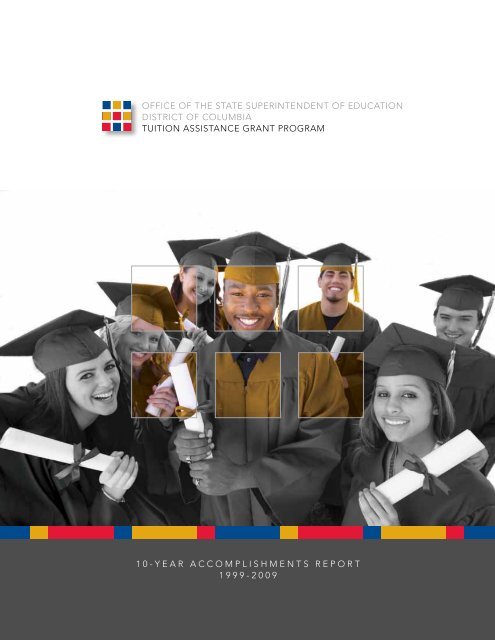
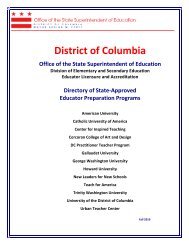
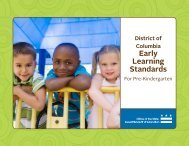


![DC Special Education Memorandum [PDF] - osse](https://img.yumpu.com/26875015/1/190x245/dc-special-education-memorandum-pdf-osse.jpg?quality=85)

